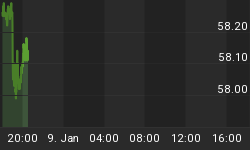We now have had a weaker Employment number than was expected, and a softer CPI figure than was expected. Bernanke is sounding increasingly strident about the need to flush even more money into the system (the operative word here may be "flush"). The only mystery left about QE2 is how big it will be, and whether the Fed will also eliminate the payment of interest on excess reserves (IOER), without which the quantitative easing is likely to be fairly ineffectual in the near-term. There is some small suspense about timing, but it would be hard to come up with a good reason to delay past November if, in fact, the Fed feels that QE is necessary at all. With many of the Fed speakers having held forth recently, only two seem to have serious reservations about the plan (Fisher and Hoenig). Those guys aren't going to come around any time soon (Hoenig because he is entrenched; Fisher because he is strongly influenced by the gold price), so the Committee is unlikely to develop a stronger consensus a month later. So why wait?
The CPI figure was surprising, and presumably doubly so to those investors who had been buying TIPS with reckless abandon over the last week. The inflation markets set back hard, although the weakness retraced only a very small part of the recent outperformance. That market still looks very strong, as well as currently expensive with real yields negative to 2017 and only 0.45% at the 10-year point.
The internals of the CPI figure, however, have turned more broadly disinflationary than has recently been the case. The deflationary sectors are still Recreation (-1.3% y/y), Apparel (-1.2%), and Housing (approximately -0.9% y/y ex-energy), with Housing of course being the largest chunk of that. Those three major groups are around 3/5 of the core index. Transportation (+4.6%) and Medical Care (+3.4%) still are rising relatively robustly, but Education & Communication (+1.6%) and Other (+1.5%) are edging closer to being flat. Core inflation ex-Shelter, which I have long been highlighting as being a better indicator of current inflationary trends in a post-housing-bubble world, dropped to 1.7%, the lowest it has been since early 2009. (Incidentally, that series is now available as a Bloomberg series: CPUPC+SL Index.)
The chart below shows Core-ex-Shelter. My assumption for some time has been that once housing stopped deflating, the core inflation number would begin to rise back towards core-ex-housing, but I have to admit the possibility that the housing deflation and the anemic money growth has lasted so long that perhaps the causal river is flowing the other way, and price trends are being dragged lower by the behavior of post-bubble housing.

Core ex-Shelter is softer but clearly not in deflation-danger zone.
To me, this chart still seems to be in a broad uptrend, and I would worry more about this picture if (a) my models didn't have a bottom in core CPI predicted this month anyway (base effects create the risk of one more tick lower next month), and (b) the Fed wasn't warming up the printing machine. I am skeptical that QE2 will have a rapid effect, but I am even more skeptical that deflation can take hold when the three major central banks are all racing to see who can add the most liquidity. Still, this chart bears watching.
















